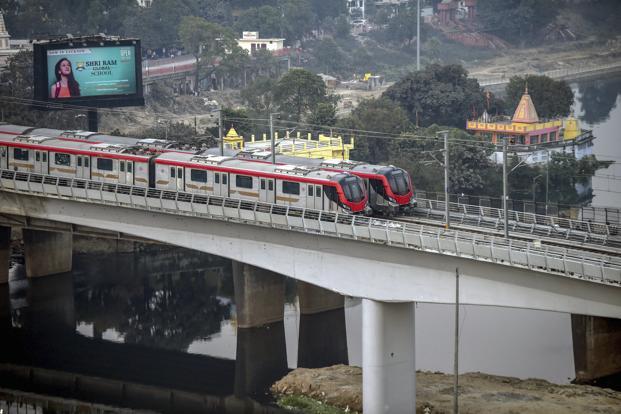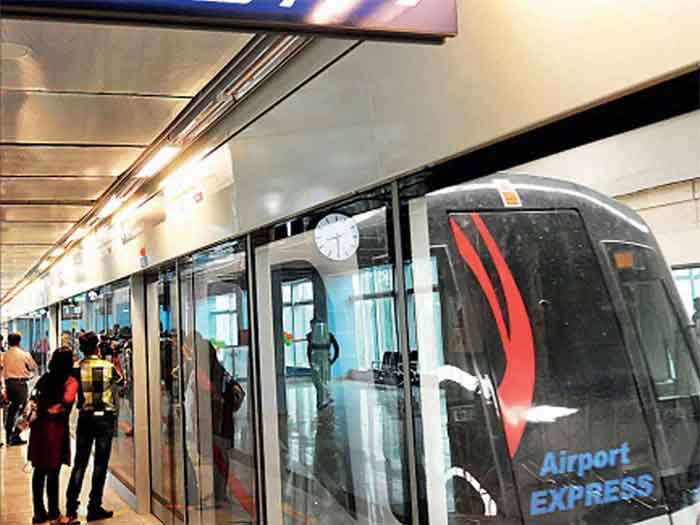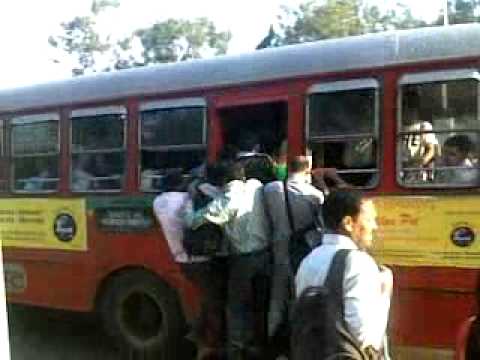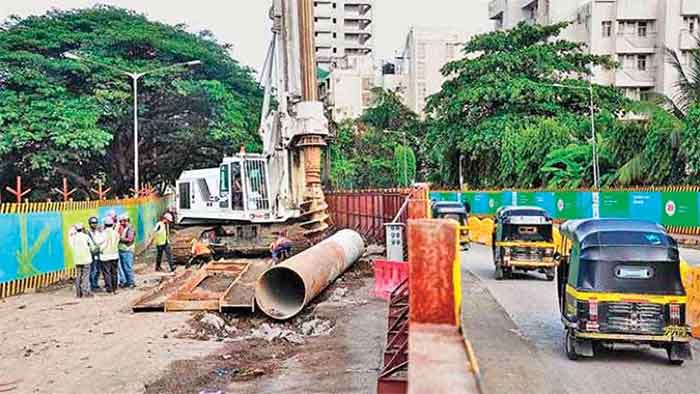
A recent issue of the well-known international journal Economist exposes the Indian government’s misleading claims about the Metro rail network in the country.
Not one of the Metro lines in the country carries commuters even half its capacity, the journal points out. The article is behind a paywall.
It also points out that it is wrong to ignore low cost options like the urban bus system.
Some experts in India have been making these points for long but they have little visibility while much of the Indian media is working without any self respect like a servile public relations machinery for the Metro system, presenting a false, rosy picture, rolling out press releases, obscuring the massive failures the Metro has been in several cities.
Not one of India’s metro rail systems has achieved even half its projected ridership, according to a study by Geetam Tiwari and Deepty Jain of the Indian Institute of Technology in Delhi. Only their own city’s network, which is the longest and most expansive in India, comes close, at 47%. In Mumbai and Kolkata ridership is a third of what was projected. In most other cities it is in single or low double digits. In gridlocked Bangalore, India’s tech-and-traffic capital, a much ballyhooed metro’s first line attracts just 6% of its projected ridership. That is despite the fact that the average speed for cars during Bangalore’s rush-hour is 18kph, the slowest of any major city bar London, according to TomTom, a navigation-software firm.
What explains the reluctance of commuters to hop aboard their shiny new, delightfully air-conditioned, metro carriages? For starters, Indian cities are not particularly dense, which means metro lines are not within walking distance for most commuters. Feeder services, such as bus routes, are rarely integrated with metro lines. So taking the metro to work can be complicated and involve walking, buses, shared autorickshaws and more walking, the Economist points out.
One point the Economist and many experts are not making is that the Indian authorities have shown absolute contempt for ordinary people and their needs, their basic need is for a flexible bus system. But this is precisely what the authorities are discriminating against. While thousands of crores are being squandered on the Metro, the bus system is being denied small amounts, its fleet is dwindling instead of growing, vacancies of permanent employees are not being filled, a totally failed privatisation model is being imposed.
The Economist also does not mention the utter lack of planning and poor execution of some of the Metro lines. The authorities are completely clueless about raising of funds for this hideously expensive project, they are our to monetise public land robbing the people of their much needed resource for basic amenities. There is large scale mismanagement.
Also, there is widespread propaganda in the media about the the high speed of Vande Bharat trains, the fact is they are not at all running at the high speeds they are supposed to be running, they are expensive, meant for the rich and are having a very negative impact on the running of trains used by other people, points out Ashok Datar, transport analyst.
According to an analysis by Sudhir Badami, a civil engineer from IIT-Bombay with 40 years of professional experience, the planned 487 km of Metro Rail network will take a very long time, 17 years from today and assuming eight-coach rakes operating at three minute frequency, would meet barely 80 per cent of today’s needed capacity.
https://www.mid-day.com/mumbai/mumbai-news/article/heres-how-mumbais-metro-is-coming-along-23296434
Experts point out that there is a massive failure on the part of Metro railway in India on several fronts, starting from preparing project reports, there are serious financial problems, the Central government has driven state governments to launch Metro services, they went ahead on the assumption that it will finance at least part of the project but funds are in absolute short supply. There is confusion all around.
Truth remains hidden from the public because of the Metro’s managing the media.
MMRDA, operating most of the Metro construction work, has completely lost face and credibility with its failure to deal with the traffic congestion mess in its own vicinity in the Bandra Kurla complex. Somit Sen and Manthan Mehta focussed on the issue in Mumbi Mirror recently. . The media has ignored the phenomenon for too long.
The mess is the creation of MMRDA itself and the political masters. What on earth all these officials do with so much of engineering and planning staff ? First they must walk around or at least take a vehicle and see how it is insulting common people day in and day out. The footpath between the court and electricity board office to Bandra east side of the station will put to shame even one in a backward state.
It is totally unpaved, uneven, in the night it is dark, so full of hazards.
With such poor management even of basics, no wonder the Metro rail network is in such a mess. What kind of economics and planning these people have learnt ?
And look at the double standards, the slavishness to the rich and contempt for the poor. MMRDA wants to build special nice roads between buildings of the rich and Metro stations and it has such wretched walking space for ordinary people , such poor connectivity to suburban stations.
The bus is an infinitely lower cost option. But it is discriminated against all the time. Besides, bus infrstrastrcture requires very little space, they can have hundreds of more buses, there is enough space to put them in the BEST depots. In contrast, the Metro has robbed the city of hundreds of acres of public space. And there is no indication of relief from this absolute menace for the next few months if not years. A lot of heads need to fall but they won’t because the rot starts from the top.
It is clear , as far as Delhi is concerned that the metro is part of a larger agenda driven by a group of select ‘stakeholders’ to transform Delhi into a ‘world class city’ for facilitating and encouraging inflow of global capital, points out Dunu Roy, an IIT trained engineer with wide experience analysis of urban, economic issuesd in governance.
The late Dinesh Mohan , expert on urban transport planning had rightly pointed out that most planners and consultants are also ignorant of the modern scientific evidence on these issues. And this is not likely to change in a hurry unless our academic institutions establish centres of excellence to work on complex urban problems, including transport. Such efforts are necessary if we want to keep track of new developments nationally and internationally. Air-conditioned, comfortable, safe and quiet travel in cars with music in hot and tropical climates cannot be easily matched by public transport. Evidently, such vehicle owners would rather live in congestion than brave the hot climate on walking access trips and the jostling in public transport. If public transport is to be made more appealing, it has to come closer to home than underground or elevated systems can, reduce walking distances and be very predictable. These conditions would favour high density networks, lower capacity surface transport systems (to reduce walking distances) with predictable arrival and departure times aided by modern information systems.
Similarly, high income countries never experienced wide ownership of two-wheelers. This is a new phenomenon, especially in Asia. The efficiency of two-wheelers – ease of parking, high manoeuvrability, overtaking in congested traffic, and low operating costs make them very popular in spite of travel being very hazardous. Easy availability of two-wheelers has further reduced the middle class demand for public transport. In addition it has put a low limit on the fare levels that can be charged by public transport operators. It appears that public transport cannot attract these road users who can afford two-wheelers unless the fare is less than the marginal cost of using one. At current prices this amounts to less than one rupee per kilometre. It is difficult to operate any clean public transport system at this fare, certainly not elevated or underground systems. The only option available is to design very cost efficient surface transport systems.
The late Mr K.V. Sivaramakrishnan, a former urban development secretary, was one of the few who understood urban issues. He had pointed out some time ago that the present scenario in Indian cities indicates that urban transport as a subject falls through the gaps between several institutions and is indeed ‘nobody’s baby’. In the meantime, market forces continue to encourage proliferation of private transport and pre-emption of public choices. The situation is unlikely to change until congestion and pollution bring movement on the megacity roads to a virtual halt. His words are more than relevant now.
The lies told by the Metro authorities are now exposed to some extent in the media abroad. The skeletons are coming out in the Indian media but to a very small extent, and they still exert enormous power in India with all the money they have got through loans and robbing more robust and low cost transport modes of funds,.
The enormous air of self importance of some of the Metro executives despite an abject performance is to be seen to be believed. They are garnering endless publicity with their smiling pictures , wearing suits.
All this is laughable, ridiculous, annoying. The latest onslaught is a big media campaign for a conference of these people and industries allied with the Metro to be held next month in Mumbai in a luxury hotel. My experience of several years tells me few of them are worth listening to, they have little experience in transport planning, and yet the fee for the conference for a single day is above Rs. 10,000. No doubt the money will come from captive Metro rail projects.
There is no transparency in their operations at all. I noticed at two international conferences on urban mobility I attended that the Metro people do not want to face genuine people in the mobility field. They held their own private consultations at these conferences. Naturally, they will be exposed in no time if they were probed by serious minded people who cannot be taken for a ride.
Vidyadhar Date is a senior journalist and author of the book Traffic in the era of climate change. Walking, cycling, public transport need priority
















































